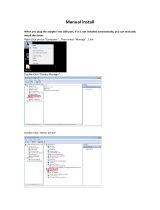
v
TABLE OF CONTENT
ABOUT THIS GUIDE .................................................................................... 1
Purpose ....................................................................................................................................................................................................... 1
Terms/Usage .............................................................................................................................................................................................. 1
Overview of this User’s Guide .................................................................................................................................................................. 1
INTRODUCTION ........................................................................................... 2
Applications: .............................................................................................................................................................................................. 2
Supported Features: ................................................................................................................................................................................... 3
Wireless Performance Considerations ...................................................................................................................................................... 4
UNPACKING AND SETUP .............................................................................. 5
Unpacking .................................................................................................................................................................................................. 5
Setup ........................................................................................................................................................................................................... 5
HARDWARE INSTALLATION ......................................................................... 6
Front Panel ................................................................................................................................................................................................. 6
Rear Panel .................................................................................................................................................................................................. 7
Side Panel ................................................................................................................................................................................................... 8
Hanging Way ............................................................................................................................................................................................. 8
Hardware connections ............................................................................................................................................................................... 9
Connecting the WLAN Router .............................................................................................................................................................. 9
Check the installation ............................................................................................................................................................................ 9
PC NETWORK TCP/IP SETTING ............................................................... 10
Windows 95/98/ME ................................................................................................................................................................................. 10
Windows 2000 ......................................................................................................................................................................................... 11
Windows XP / Vista ................................................................................................................................................................................ 12
CONFIGURATION ....................................................................................... 13
Login to the WLAN Router through Wireless LAN .............................................................................................................................. 13
Login to the WLAN Router ..................................................................................................................................................................... 13
Using the Web Browser ........................................................................................................................................................................... 13
Setup Wizard ............................................................................................................................................................................................ 14
Advanced configuration........................................................................................................................................................................... 27
Main ......................................................................................................................................................................................................... 27
LAN & DHCP Server .......................................................................................................................................................................... 27
WAN .................................................................................................................................................................................................... 28
Password .............................................................................................................................................................................................. 29
Time ..................................................................................................................................................................................................... 30
Dynamic DNS ...................................................................................................................................................................................... 31
Wireless .................................................................................................................................................................................................... 31
Basic ..................................................................................................................................................................................................... 31
Security ................................................................................................................................................................................................ 33
Advanced ............................................................................................................................................................................................. 36
Wi-Fi Protected Setup ......................................................................................................................................................................... 37
Status ........................................................................................................................................................................................................ 38
Device Information .............................................................................................................................................................................. 38
Log ....................................................................................................................................................................................................... 39
Log Setting ........................................................................................................................................................................................... 40






















